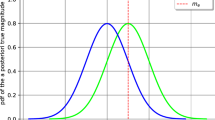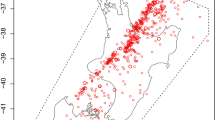Abstract
An estimation approach for the semi-parametric intensity function of a class of space-time point processes is introduced. In particular we want to account for the estimation of parametric and nonparametric components simultaneously, applying a forward predictive likelihood to semi-parametric models. For each event, the probability of being a background event or an offspring is therefore estimated.







Similar content being viewed by others
References
Adelfio G, Chiodi M, De Luca L, Luzio D, Vitale M (2006) Southern-Tyrrhenian seismicity in space-time-magnitude domain. Ann Geophys 49:1245–1257
Adelfio G, Chiodi M (2009) Second-order diagnostics for space-time point processes with application to seismic events. Environmetrics 20:895–911
Adelfio G, Schoenberg FP (2009) Point process diagnostics based on weighted second-order statistics and their asymptotic properties. Ann Inst Stat Math 61:929–948
Adelfio G (2010) An analysis of earthquakes clustering based on a second-order diagnostic approach. Data analysis and classification. Springer, Berlin, pp 309–317
Adelfio G, Chiodi M, Luzio D (2010) An algorithm for earthquake clustering based on maximum likelihood. Data analysis and classification. Springer, Berlin, pp 25–32
Adelfio G, Chiodi M (2011) Kernel intensity for space-time point processes with application to seismological problems. In: Fichet S (ed) Classification and multivariate analysis for complex data structures. Springer, Berlin, pp 401–408
Balderama E, Schoenberg FP, Murray E, Rundel PW (2012) Application of branching point process models to the study of invasive red banana plants in Costa Rica. JASA 107(498):467–476
Becker N (1977) Estimation for discrete time branching processes with application to epidemics. Biometrics 33(3):515–522
Caron-Lormier G, Masson JP, Menard N, Pierre JS (2006) A branching process, its application in biology: influence of demographic parameters on the social structure in mammal groups. J Theo Biol 238:564–574
Chiodi M, Adelfio G (2011) Forward Likelihood-based predictive approach for space-time processes. Environmetrics 22:749–757
Choi E, Hall P (1999) Nonparametric approach to analysis of space-time data on earthquake occurrences. J Comput Graph Stat 8(4):733–748
Choi E, Hall P (2001) Nonparametric analysis of earthquake point-process data. Lect Notes-Monograph Ser 36:324–344
Console R, Jackson DD, Kagan YY (2010) Using the ETAS model for catalog declustering and seismic background assessment. Pure Appl Geophys 167:819–830
Daley DJ, Vere-Jones D (2003) An introduction to the theory of point processes. Springer, New York
Diaz-Avalos C, Juan P, Mateu J (2013) Similarity measures of conditional intensity functions to test separability in multidimensional point processes. Stoch Environ Res Risk Assess 27(5):1193–1205
Fraley C, Raftery AE (2002) Model-based clustering, discriminant analysis and density estimation. J Am Stat Assoc 97:611–631
Gardner J, Knopoff L (1974) Is the sequence of earthquakes in southern California, with aftershock removed, poissonian? B Seimol Soc Am 64:1363–1367
Jagers P, Klebaner FC (2000) Population-size-dependent and age-dependent branching processes. Stoch Process Appl 87:235–254
Johnson RA, Taylor JR (2008) Preservation of some life length classes for age distributions associated with age-dependent branching processes.Stat Probabil Lett 78:2981–2987
Juan P, Mateu J, Saez M (2012) Pinpointing spatio-temporal interactions in wildfire patterns. Stoch Environ Res Risk Assess 26(8):1131–1150
Marsan D, Lenglin O (2008) Extending earthquakes’ reach through cascading. Science 319:1076–1079
Ogata Y (1988) Statistical models for earthquake occurrences and residual analysis for point processes. J Am Stat Association 83:9–27
Resenberg P (1985) Second-order moment of central california seismicity, 1969–1982. J Geophys Res 90(B7):5479–5495
Schoenberg FP, Peng R, Woods J (2003) On the distribution of wildfire sizes. Environmetrics 14:583–592
Silverman B (1986) Density estimation for statistics and data analysis. Chapman and Hall, London
Terrell GR, Scott DW (1992) Variable Kernel density estimation. Ann Statist 20(3):1236–1265
Veen A, Schoenberg FP (2008) Estimation of space-time branching process models in seismology using an EM-type algorithm. JASA 103(482):614–624
Vere-Jones D (1992) Statistical methods for the description and display of earthquake catalogues. In: Walden A and Guttorp P (eds) Statistics in the environmental and earth sciences, Edward Arnold, London, pp. 220–236
Wand MP, Jones MC (1994) Multivariate plugin bandwidth selection. Comput Stat 9:97–116
Zhuang J, Ogata Y, Vere-Jones D (2002) Stochastic declustering of space-time earthquake occurrences. J Am Stat Assoc 97:369–379
Acknowledgments
We would like to thank the Editor and the two referees for their fruitful and insightful comments. This paper has been partially supported by the Grant of University of Palermo (Italy): “2012-ATE-0332-FFR 2012-2013-Metodi statistici per dati spazio-temporali applicati all’analisi, monitoraggio e previsione ambientale” G. Lovison.
Author information
Authors and Affiliations
Corresponding author
Rights and permissions
About this article
Cite this article
Adelfio, G., Chiodi, M. Alternated estimation in semi-parametric space-time branching-type point processes with application to seismic catalogs. Stoch Environ Res Risk Assess 29, 443–450 (2015). https://doi.org/10.1007/s00477-014-0873-8
Received:
Accepted:
Published:
Issue Date:
DOI: https://doi.org/10.1007/s00477-014-0873-8




